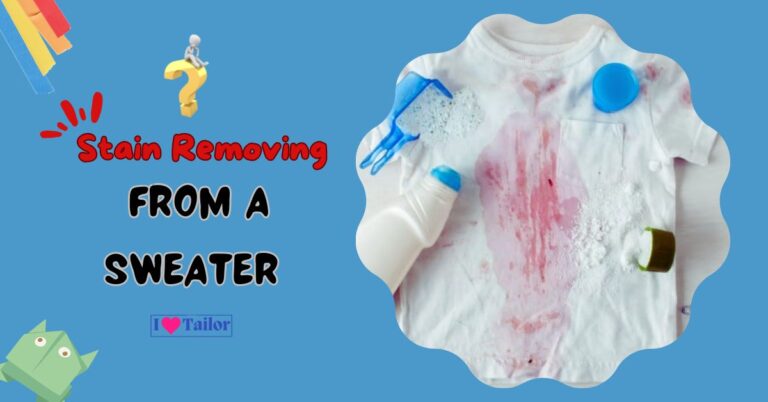Will vinegar get fiberglass out of clothes?
Fiberglass is a multipurpose material that is extensively utilized in many sectors, including the building and automobile industries. It has unquestionable advantages, when unintentionally embedded in garments, this fabric made of fine glass strands may present serious problems. The fiberglass shards are notoriously difficult to remove and can cause itchiness and discomfort. One home remedy that has been suggested for removing fiberglass is vinegar, a staple in many households due to its many uses. This article delves into the question, “Will vinegar get fiberglass out of clothes?“
Also read: How to get the highlighter out of clothes?
What is fiberglass?
As the name indicates, fiberglass is a kind of fiber-reinforced plastic that uses glass fiber. A composite made of strong but lightweight tiny glass strands and a synthetic substance is how it is made. This versatility has led to its wide use across multiple industries. From automotive bodies and boat hulls to housing insulation and fiberglass tape, this material has proven to be highly adaptable due to its unique properties.
Does vinegar remove fiberglass from clothes?
Yes, vinegar is effective in removing fiberglass from clothing. The vinegar’s acid content aids in the breakdown of the fiberglass, making it simpler to remove from the cloth. Vinegar is a practical choice since it is a typical home component. However, it’s essential to note that vinegar alone might not always be sufficient to remove all the particles, and the clothes might need further washing or treatment.
The Role of Vinegar in Laundry
Vinegar is a proven, reliable household product with a vast range of applications, including laundry. Its acidic nature makes it effective for breaking down residues and eliminating odors. Vinegar also serves as a fabric softener and can help prevent colors from fading. Its natural deodorizing properties make it an effective tool for removing unpleasant smells from clothes, including those resulting from mildew or sweat.
The connection between fiberglass and vinegar
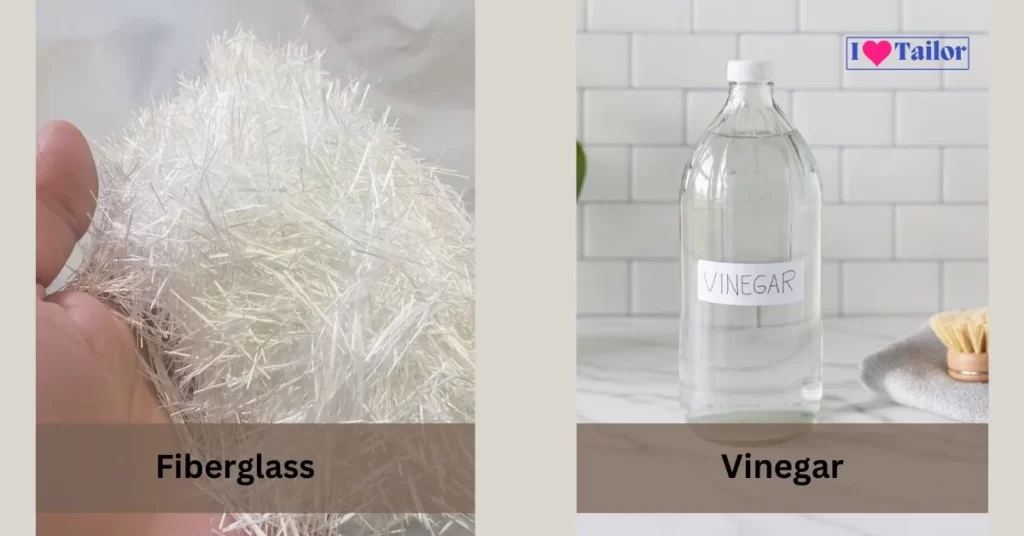
Vinegar and fiberglass may seem like two unrelated substances, but they have a very important connection when it comes to removing fiberglass from clothes. Fiberglass consists of very thin particles of glass woven together. When these particles embed themselves into clothing, they can cause uncomfortable skin irritation. Removing them can be challenging due to their tiny size and the way they cling to fabric.
Vinegar, specifically white vinegar, plays a crucial role in this scenario due to its mild acidic properties. Vinegar’s acidity helps dissolve and weaken the bond between fiberglass dust and textile fibers. This facilitates the removal of fiberglass from textiles during subsequent washes and rinses. So, the connection between fiberglass and vinegar is that vinegar may be used to effectively remove fiberglass from garments.
Steps to use vinegar to remove fiberglass from clothes
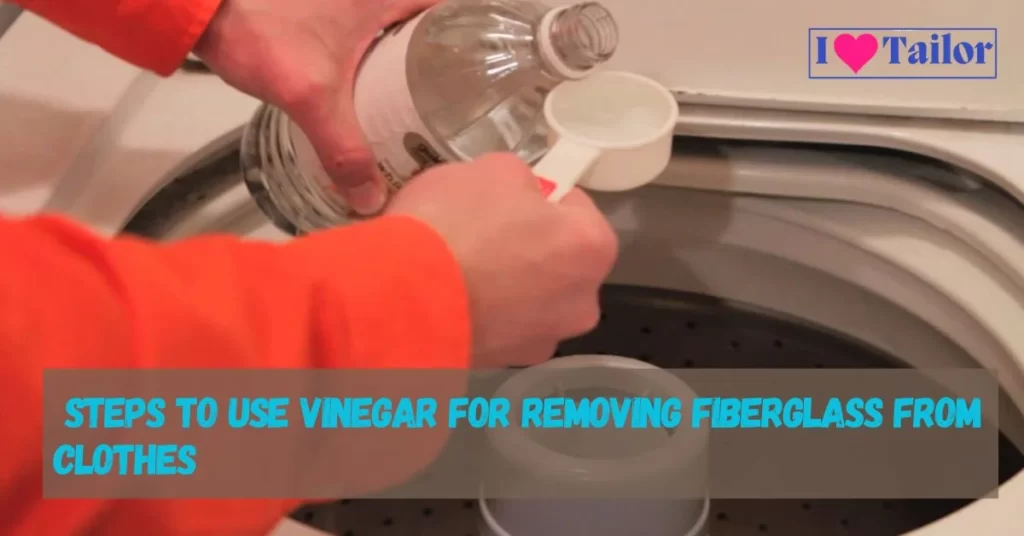
- Identify the affected clothes: The first step in cleaning fiberglass out of clothing is to determine which things need to be cleaned. Wearing these kinds of clothes is standard practice while working with fiberglass insulation. Because fiberglass fibers stick so readily to fabric, it is important to wash these garments separately from the rest of your laundry.
- Rinse with cold water: Before applying the vinegar, give the garments a thorough rinsing in cold water. Using cold water might aid in loosening some of the fiberglass strands. If you want to keep the fibers from being permanently lodged in the cloth, cold water is the way to go. This process requires caution so that fiberglass doesn’t go everywhere.
- Prepare a vinegar solution: Third, prepare a vinegar solution by mixing equal parts white vinegar and warm water. Vinegar’s acidity dissolves the adhesive between the fiberglass strands and your clothing. The standard ratio of vinegar to water is 1:1; however, this may be changed to suit individual needs. You want to use enough vinegar to get the job done, but you don’t want to risk damaging the garments in the process.
- Soak the clothes: Completely soak the stained garments in the vinegar solution. For best results, make sure the whole article of clothing is submerged in the solution. Soak the garments for at least an hour. It’s important to provide adequate time for the vinegar to react with the fiberglass.
- Rinse again with cold water. After the soaking period, rinse the clothes again with cold water. This second rinse will remove any vinegar remaining on the clothes and wash away any fiberglass fibers that have been loosened by the vinegar soak. Be careful during this step to avoid any contact with loose fiberglass fibers.
- Wash normally: Following the second rinse, wash the clothes as you usually would. Use your regular laundry detergent and follow the care instructions on the clothing labels. The agitation from the washing machine should help remove any remaining fiberglass fibers.
- Air dry: Finally, air dry the clothes. To prevent any leftover fiberglass fibers from being permanently entrenched in the fabric, a tumble dryer should be avoided. The items should be hung in a well-ventilated location to dry.
Precautions to take before using vinegar to dissolve fiberglass
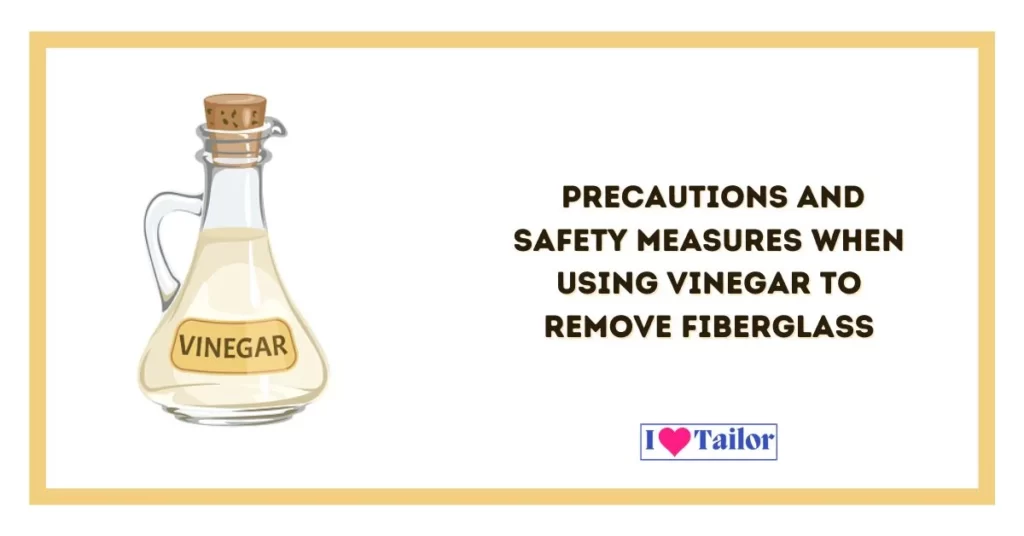
Precautions and safety measures to take before using vinegar to remove fiberglass
- Wear protective clothing. First, always protect yourself by dressing in layers while working with clothing that has embedded fiberglass. Long sleeves, long trousers, gloves, and goggles are all essential pieces of gear. Skin and eye protection should be used while working with fiberglass because of the risk of irritation.
- Avoid direct contact with skin: Second, fiberglass particles may be dangerous if they come into contact with the skin; therefore, it’s best to keep your distance. Therefore, while handling clothing that may be contaminated with fiberglass, it is best to avoid contacting your face and other exposed skin regions.
- Use gloves: Always use gloves when handling clothes affected by fiberglass. This will protect your hands from irritating fiberglass particles.
- Don’t scrub or rub the clothes; doing so can cause the fiberglass particles to embed deeper into the fabric, making them harder to remove. It can also spread the particles, potentially causing further contamination.
- Clean your washing machine afterward: After washing clothes contaminated with fiberglass, clean your washing machine thoroughly to ensure that no fiberglass particles remain that could contaminate your next laundry load.
- Ventilate your space. If possible, hang the clothes out to dry in a well-ventilated outdoor area. This will help to disperse any remaining fiberglass particles into the air, reducing the risk of them causing further skin irritation or getting into your indoor air.
- Avoid inhaling fiberglass particles. If you suspect that there are fiberglass particles in the air, consider wearing a mask or respirator to avoid inhaling them. Fiberglass particles can be harmful if inhaled.
Alternatives to Vinegar for Removing Fiberglass from Clothes
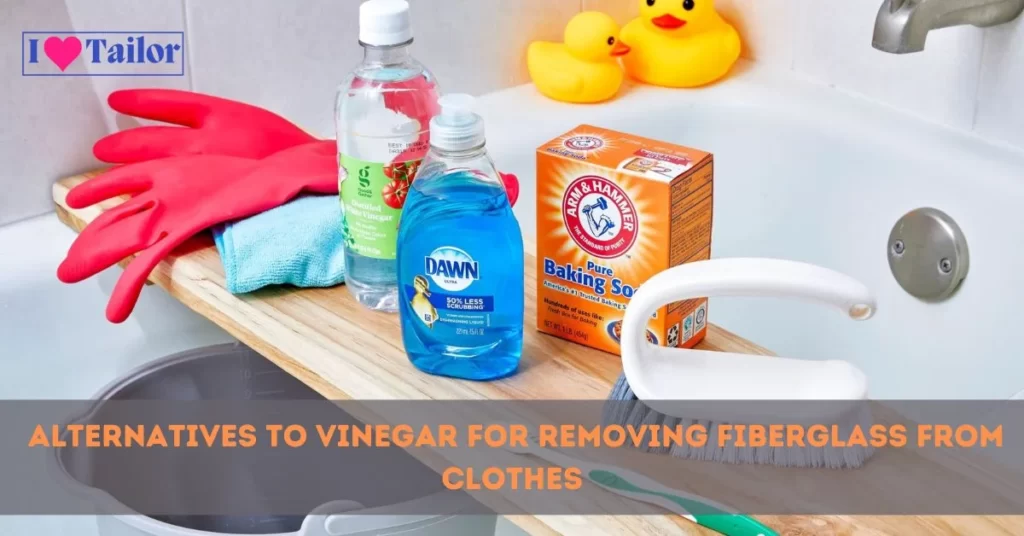
Baking Soda:
Baking soda, also known as sodium bicarbonate, is a common household ingredient that you can use to get fiberglass out of clothes. It’s a mild alkali that helps dislodge the fiberglass fibers from the fabric.
- Step 1: Fill your washing machine or basin with cold water.
- Step 2: Add half a cup of baking soda and stir until it is dissolved.
- Step 3: Submerge your affected clothes in the solution and let them soak for about an hour.
- Step 4: After soaking, wash the clothes as you usually would. Use your regular laundry detergent and follow the care instructions on the clothing labels.
- Step 5: Once the wash cycle is complete, air dry the clothes. This can help dislodge any remaining fiberglass fibers.
Cold water and brushing:
This method is simple and often quite effective. It works best when the fiberglass contamination is not too severe.
- Step 1: Rinse the affected clothes in cold water. The water can help to loosen and wash away some of the fiberglass fibers.
- Step 2: Lay out the wet clothes on a hard, clean surface.
- Step 3: Using a soft-bristled brush, gently brush the fabric. The brush can help dislodge the embedded fiberglass fibers. Be sure to brush only in one direction to prevent pushing the fibers further into the fabric.
- Step 4: After brushing, rinse the clothes again in cold water and then wash normally.
Professional Cleaning Services:
If the fiberglass contamination is severe or if the clothes are delicate or expensive, it might be best to seek professional help. Many dry cleaners offer specialized cleaning services for removing contaminants like fiberglass.
- Step 1: Identify the affected clothes and keep them separate from other clothing items to prevent the spreading of the fibers.
- Step 2: Take the clothes to a professional dry cleaner. Be sure to inform them about the fiberglass contamination so they can use the appropriate cleaning process.
- Step 3: After the clothes have been professionally cleaned, store them in a clean, dust-free area to prevent future contamination.
FAQs
Can I use any type of vinegar to remove fiberglass?
White vinegar is recommended due to its high acidity and lack of staining risks.
Is at-home fiberglass removal safe?
Yes, if safety precautions are followed, including protective wear and thorough washing machine cleaning.
How long should I soak clothes in a vinegar solution?
Soak for about an hour to allow the vinegar to loosen the fiberglass fibers.
What if one treatment isn’t enough?
Repeat the process or consider alternative methods or professional services for stubborn cases.
Is this method safe for all fabric types?
Generally, yes, but check clothing care labels and consult a professional for delicate fabrics.
Conclusion
In conclusion, dealing with fiberglass in clothing can be a tricky process, but there are practical solutions available. Vinegar, with its mild acidity, is an excellent and readily available tool that can assist in loosening and removing those pesky fiberglass fibers.
By following the steps provided and adhering to the necessary safety precautions, you can effectively remove fiberglass from your clothes, reducing discomfort and potential health risks. So, the next time you find yourself in a sticky situation with fiberglass on your clothing, remember these tips and take control of the situation effectively and safely.
Thanks!
Also read: How to get Vicks out of clothes?




